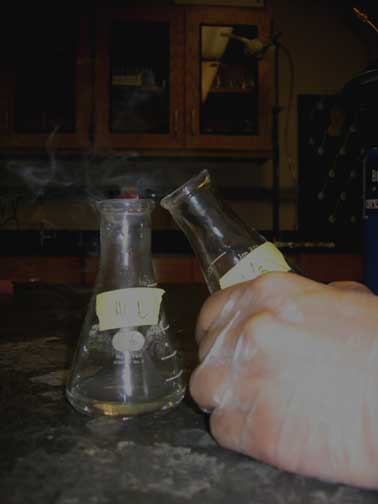Precipitation out of not so thin air
 The vapors rising above two flasks are allowed to mingle, precipitating results.
The vapors rising above two flasks are allowed to mingle, precipitating results.
Ingredients: ammonia solution, hydrochloric acid solution
Procedure: A minimal recipe follows.
1. Prepare a concentrated solution of ammonia and place in Erlenmeyer flask.
2. Prepare a concentrated solution of hydrochloric acid and place in Erlenmeyer flask.
3. Allow the vapors rising above the two flasks to mingle and observe the results.
Understanding: This is a great reaction to open your sinuses. The reaction of ammonia gas with vapors rising above a hydrochloric acid solution leads to the precipitation reaction
NH3(g) + HCl(g) → NH4Cl(s)
As the vapors combine above the flasks, the acid-base reaction between ammonia and hydrochloric acid takes place, leading to the formation of ammonium chloride. The ammonium chloride is observed to be wisps of white vapor floating above the flasks.Thinking of the molecular shapes of the reactants and products, the trigonal pyramidal ammonia molecule encounters the linear hydrogen chloride molecule. The reaction results in a proton transfer from the hydrogen chloride to the ammonia, leading to a tetrahedral ammonium ion associated with a chloride ion as solid ammonium chloride.
The salt ammonium chloride is commonly sold as "sal ammoniac." Another salt of ammonia, ammonium carbonate, (NH4)2CO3, is a chemical used as smelling salts. Breaking open a capsule of ammonium carbonate leads the salt to dissociate and produce ammonia. The ammonia is transported into the nostrils of the stunned patient, bringing the "back to life."
Sense of smell and natural selection
Question: Humans are quite sensitive to the smell of ammonia. Why would natural selection have lead to olfactory systems able to sense ammonia in relatively low concentrations? Does a sensitivity to the presence of ammonia provide an organism with an "evolutionary advantage" in the process of natural selection?